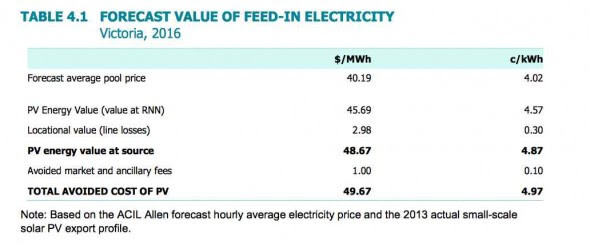Victorian solar households face another cut to their solar feed-in tariff, after the Essential Services Commission recommended the rate for rooftop solar generation fed back into the grid be cut to 5c/kWh, from the current level of 6.2c/kWh in 2016.
The recommendation, included in a report released this week, suggested that the falling cost of wholesale electricity prices – coincidentally the result of reduced demand and increased renewable energy – justified the cut.
This graph illustrates the findings of the ESC and how it got to its numbers.
The forecast average pool price is self explanatory. The value of PV is higher because of when the electricity is generated (in the middle of the day), and rooftop solar is credited with avoiding line losses (5 per cent of electricity generated from centralised plants never make it to the customer). And there is a small sum for avoided “market and ancillary fees”
The solar industry has long criticised pricing regulators in Australia for estimating only the avoided costs of rooftop solar and not crediting it with any benefits.
For instance, apart from avoided line losses, there is no credit for network benefits, or environmental benefits. The contrast with some US states, where pricing regulators put the “fair” solar tariff at close to the retail price, is striking.
The ESC itself says that – like other Australian regulators – it does not include “any savings in relation to the following types of costs when quantifying the FiT: network costs, hedging costs, green scheme costs and retailer costs.”
The solar lobby says this is not good enough: “The Victorian Government should reject any recommendation by the electricity price regulator to unfairly reduce the state’s solar feed-in tariff,” the Solar Citizens group said in a statement.
“The main driver behind power bill price rises is investment in network poles and wires, not solar homes.”
Victoria is predicted by the Australia Energy Market Operator to be one of the biggest adopters of battery storage in Australia, particularly for new solar homes. This is partly due to the structure of tariffs, such as the low FiTs that are paid in various states and in Victoria in particularly.
The ESC will make a final decision later this year. The new Labor government has promised an investigation into the “fair price”of solar.
© 2015 Solar Choice Pty Ltd
